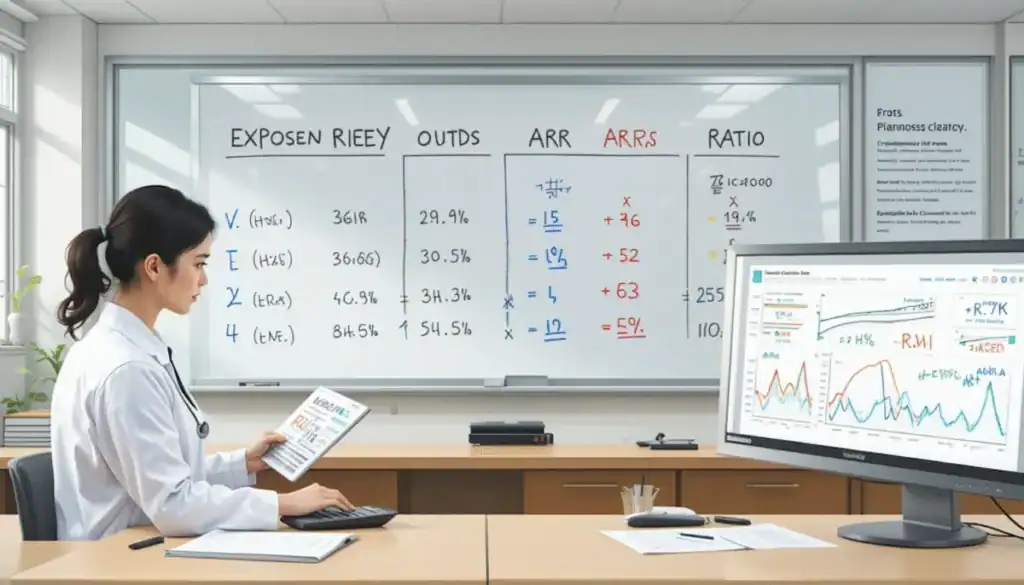Welcome to the first post in our Epidemiology and Biostatistics Crash Course. In this article, we’ll explore different types of research study designs — their definitions, examples, advantages, and key differences. Whether you’re preparing for USMLE, NEET-PG, or medical research writing, this guide will give you the foundation you need.
🔍 1. Case Study
A Case Study is an in-depth analysis of a single unusual or interesting patient case.
🧪 Example: A medical student eats a poisoned apple and is brought to the ER. The physician finds the case unique and writes a paper to share the presentation and findings. This is a classic case study.
✅ Best for: Rare diseases or unusual presentations
🚫 Limitation: Cannot establish causality or prevalence.
📋 2. Case Series
A Case Series is a description of multiple patients with similar presentations.
🧪 Example: A series of students in a medical college report poisoned apple ingestion and present with similar symptoms. Their cases are described together.
✅ Best for: Observing patterns in similar cases
🚫 Limitation: Still no control group or statistical inference.
🔄 3. Cross-Sectional Study
A Cross-Sectional Study looks at a population at one point in time to assess the prevalence of a condition.
🧪 Example: A medical student wants to know how many students have depression. He surveys the entire college and finds that 50% of students test positive on PHQ-9.
✅ Best for: Estimating prevalence
🚫 Limitation: Cannot measure incidence or establish causality
🔹 Cross-sectional = Snapshot
🔸 Tells prevalence, not incidence
📈 4. Cohort Study
A Cohort Study follows a group over time based on exposure, to measure if they develop a certain outcome.
🧪 Example: To find out if medical students develop depression over 4 years, we follow a group of students from first year to graduation.
Two types:
- Prospective Cohort: Follows people from now into the future
- Retrospective Cohort: Uses past data and follows from exposure to outcome.
✅ Best for: Measuring incidence, assessing causality
🚫 Limitation: Can be time-consuming and expensive
🧠 Cohort = exposure → outcome
Measures risk ratio
Can be prospective or retrospective
🔍 5. Case-Control Study
A Case-Control Study starts with people who already have the outcome (cases) and compares them to those who don’t (controls), then looks backward to see exposure.
🧪 Example: We take people with lung cancer (cases) and those without (controls), and ask: Did you smoke?
✅ Best for: Rare diseases
🚫 Limitation: Subject to recall bias, cannot measure incidence
🧠 Case-control = outcome → exposure
Measures odds ratio
🌍 6. Ecological Study
An Ecological Study looks at data from entire populations or groups (e.g., countries, states) instead of individuals.
🧪 Example: A researcher compares average alcohol consumption per capita and liver disease incidence across different countries.
✅ Best for: Large-scale patterns
🚫 Limitation: Cannot apply to individuals → risk of ecological fallacy
❗ Ecological Fallacy: Making individual-level conclusions based on group-level data.
🧠 Summary Table
| Study Type | Based On | Direction | Measures | Best For | Major Limitation |
|---|---|---|---|---|---|
| Case Study | 1 patient | Descriptive | None | Unique/rare cases | No control group |
| Case Series | Similar patients | Descriptive | None | Pattern recognition | No statistical testing |
| Cross-Sectional | Population | One point in time | Prevalence | Surveys, burden estimate | No incidence/causality |
| Cohort (Prospective) | Exposure | Forward | Incidence, RR | Common diseases | Time & cost intensive |
| Cohort (Retrospective) | Exposure | Past → outcome | Risk ratio | When data already exists | Missing data |
| Case-Control | Outcome | Backward | Odds ratio | Rare diseases | Recall bias |
| Ecological | Populations | Comparative | Correlation | Public health trends | Ecological fallacy |
⚠️ Bonus Concepts:
- Risk Ratio (RR) → Used in cohort studies
- Odds Ratio (OR) → Used in case-control studies
- Ecological Fallacy → Mistake of applying group data to an individual
- Recall Bias → Common in case-control studies due to memory errors
📝 Practice Question (Quick Recap)
Q: A researcher follows 500 healthy adults for 10 years to observe who develops diabetes based on dietary fat intake.
What type of study is this?
✅ Answer: Prospective Cohort Study
📌 Final Thoughts
Understanding study designs is the foundation of evidence-based medicine. Always ask:
- What’s the exposure?
- What’s the outcome?
- Are we looking forward or backward?
- Are we comparing individuals or groups?
These questions will help you quickly identify study types in both real research and exams like USMLE or NEET-PG.



